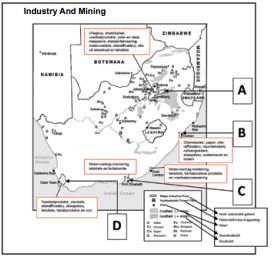GEOGRAPHY SCHOOL BASED ASSESSMENT EXEMPLARS - CAPS GRADE 12 LEARNER'S GUIDE
Share via Whatsapp Join our WhatsApp Group Join our Telegram GroupGEOGRAPHY
SCHOOL BASED ASSESSMENT EXEMPLARS - CAPS
GRADE 12
LEARNER GUIDE
| TABLE OF CONTENTS | PAGE | |||
| 1 | Introduction | 3 | ||
| 2 | Objectives/Aims of the project | 3 | ||
| 3 | Assessment tasks as outlined by CAPS | 3 | ||
| 4 | Assessment tasks | 4 | ||
| 4.1 | Term 1 – Data-handling task | 4 | ||
| 4.1.1 | Exemplar: Data-handling task 1 | 4 | ||
| 4.1.2 | Exemplar: Data-handling task 2 | 8 | ||
| 4.2 | Term 2 – Research task | 12 | ||
| 4.2.1 | Learner guidelines for conducting research | 12 | ||
| 4.2.2 | Guidelines for research | 12 | ||
| 4.2.3 | Compiling a bibliography for a research task | 15 | ||
| 4.2.4 | Proposed cover page for a research task | 17 | ||
| 4.2.5 | Exemplar: Research task 1 | 18 | ||
| 4.2.6 | Exemplar: Research task 2 | 20 | ||
| 4.2.7 | Proposed marking rubric for a research task | 22 | ||
| 5 | Conclusion | 25 | ||
1. Introduction
The purpose of this document is to provide learners with a set of benchmarked school- based assessment tasks (SBAs). It contains useful information and guidelines in the form of exemplars on the following aspects of the curriculum:
- How to do a research task
- Working with sources and source-based questions
- Data handling
- Marking rubrics as guidelines to completing research tasks
2. Objectives/Aims of the project
It is envisaged that this SBA document will provide learners with examples of SBA tasks that are of high quality and a high standard.
- A common standard is set as prescribed by the Curriculum and Assessment Policy Statement (CAPS) document.
- Quality teaching and learning of FET – Grade 12 Geography is promoted throughout all schools in South Africa.
3. Assessment tasks as outlined by CAPS
Term 1 | Term 2 | Term 3 | Term 4 |
|
|
| |
|
|
|
|
SBA mark which comprises 25% of final mark (100 marks) | 75% of final mark (300 marks) |
Term | Task | Total | SBA weight | Total | |
1 | Data handling | 60 | 20 | 100 (25%) | |
Standardised test | 100 | 10 | |||
2 | Mapwork task | 60 | 20 | ||
June Paper 1 | 200 | 300 | 10 | ||
June Paper 2 | 100 | ||||
3 | Research/Essay writing task | 60 | 20 | ||
Standardised test | 100 | 10 | |||
Trial Paper 1 | 225 | 300 | 10 | ||
Trial Paper 2 | 75 | ||||
4 | External Paper 1 | 225 | 300 | 300 (75%) | |
External Paper 2 | 75 | ||||
4. Assessment tasks
4.1 Term 1 – Data-handling task
Two examples of typical data-handling tasks are provided below.
4.1.1 Exemplar: Data-handling task 1
- Curriculum content: Physical Geography (tropical cyclones, subtropical anti-cyclones and drainage basins) • Compliant with CAPS.
- May be tested in the CAPS final external examination.
- One (1) data-handling task must be done.
GRADE 12 SBA (CAPS 2014)
DATA-HANDLING TASK
PHYSICAL GEOGRAPHY
TIME: 1 hour (60 minutes)
MARKS: 60
QUESTION 1
1.1 Refer to FIGURE 1A showing a synoptic weather map of Tropical Cyclone Irina.
1.1.1 Determine the number of tropical cyclones, including Irina, that has occurred during this tropical cyclone season. (1 x 2) (2)
1.1.2 Give a reason to support your answer to QUESTION 1.1.1. (1 x 2) (2)
1.1.3 Describe the surface air circulation within Tropical Cyclone Irina. (1 x 2) (2)
1.2 Refer to FIGURE 1B showing a satellite image of Tropical Cyclone Irina and FIGURE 1C showing the projected path of Tropical Cyclone Irina.
1.2.1 Using the satellite image, determine in which stage of development Tropical Cyclone Irina is. (1 x 2) (2)
1.2.2 Give evidence from the satellite image to support your answer to QUESTION 1.2.1 (1 x 2) (2)
1.2.3 Discuss TWO socio-economic impacts of Tropical Cyclone Irina on areas along the east coast of southern Africa. (2 x 2) (4)
1.2.4 Draw a labelled cross-section of Tropical Cyclone Irina as depicted on the satellite image from X to Y. Clearly indicate the position of the eye and the cumulonimbus clouds on your cross-section. (2 x 2) (4)
1.2.5 State the reason for the use of the words, ‘projected path’ when describing the path of Tropical Cyclone Irina. (1 x 2) (2)
1.3 Refer to FIGURE 1A.
1.3.1 Identify the high-pressure cells labelled P and Q. (2 x 2) (4)
1.3.2 Use evidence from the map to explain whether wind speed will be greater in area P or area Q. (3 x 2) (6)
[30]
QUESTION 2
2.1 Refer to FIGURE 2A showing cross-sections of the Tugela River along its course in its drainage basin shown in FIGURE 2B.
2.1.1 Define the term drainage basin. (1 x 2) (2)
2.1.2 Which of FIGURE 2A and FIGURE 2B shows a longitudinal and transverse profile respectively? (2 x 2) (4)
2.1.3 Match each of cross-sections A, B and C (FIGURE 2A) with positions (i), (ii) and (iii) (FIGURE 2B). (3 x 2) (6)
2.1.4 Briefly explain the difference in the width of the river channel at A and C. (2 x 2) (4)
2.2 Refer to FIGURE 2B showing the drainage basin of the Tugela River from its upper to the middle to the lower course.
2.2.1 Determine the stream order of the Tugela River at point X along its course. 1 x 2) (2)
2.2.2 Identify and explain ONE of the stream channel patterns of the Tugela River at (ii) along its course. (3 x 2) (6)
2.2.3 Draw a labelled free-hand cross-section through the river channel along line T–S, showing the position of and the difference in shape between a slip-off slope and an undercut slope. (2 x 2) (4)
2.2.4 Give ONE reason why the Tugela River is more likely to flood in the vicinity of (iii). (1 x 2) (2)
[30]
GRAND TOTAL: 60
FIGURE 1A: TROPICAL CYCLONE IRINA 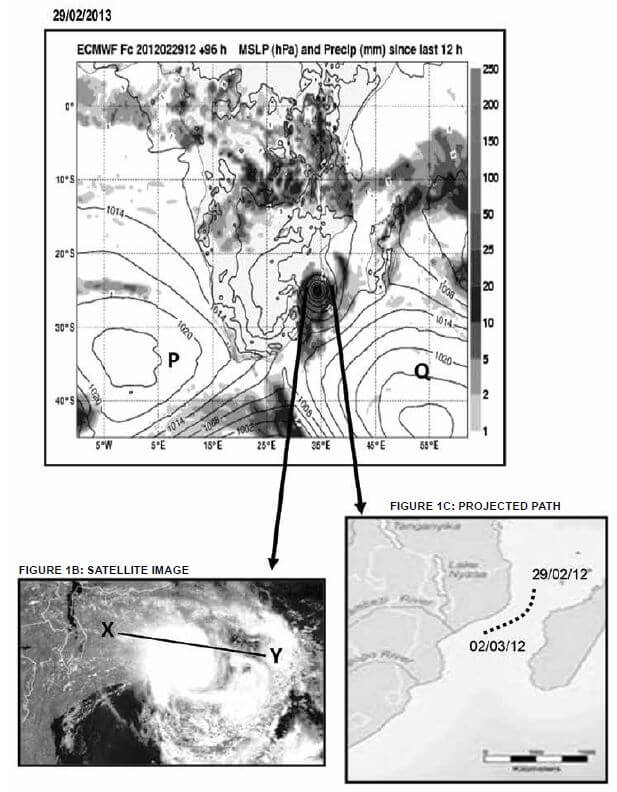
FIGURE 2A: CROSS-SECTIONS OF THE TUGELA RIVER ALONG VARIOUS POINTS 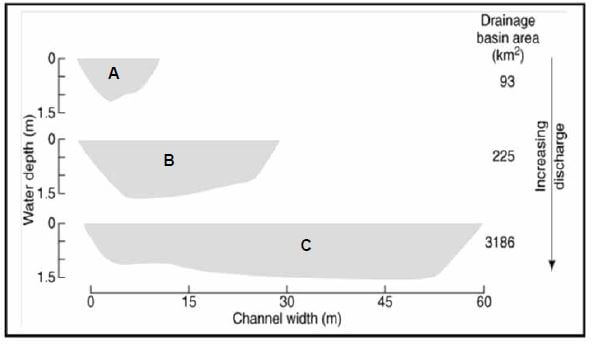
FIGURE 2B: SCHEMATIC PLAN VIEW OF THE DRAINAGE BASIN OF THE TUGELA RIVER 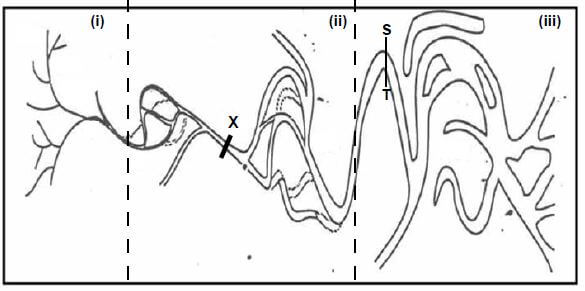
4.1.2 Exemplar: Data-handling task 2
- Curriculum content: People and their needs (gross domestic product, industrial areas, industrial development zones [IDZ])
- Compliant with CAPS.
- May be tested in the NCS and CAPS final external examination.
- One (1) data-handling task must be done.
GRADE 12 SBA (CAPS 2014)
DATA-HANDLING TASK
PEOPLE AND THEIR NEEDS
TIME: 1 hour (60 minutes)
MARKS: 60
QUESTION 1
1.1 Refer to FIGURES 1A and 1B and answer the questions that follow.
1.1.1 Define the following terms:
- Gross domestic product (1 x 2) (2)
- Balance of trade (1 x 2) (2)
1.2 Identify the largest and the smallest contributor to the South African GDP. (2 x 2) (4)
1.3 Use FIGURE 1B to describe the trend of the South African GDP from 2010 to 2012. (1 x 2) (2)
1.4 How will the trend mentioned in QUESTION 1.3 affect South Africa’s Balance of Trade? (1 x 2) (2)
1.5 Which economic activity (primary, secondary or tertiary) in FIGURE 1A accounts for the existing trend mentioned in QUESTION 1.3? (1 x 2) (2)
1.6 Discuss the relationship between the percentage contributed by agriculture to the South African GDP and food security in the country. (2 x 2) (4)
1.7 FIGURE 1A indicates that the agricultural sector contributes a very small percentage to the GDP. Write a short paragraph (approximately 12 lines) in which you account for the small contribution of the agricultural sector to the South African GDP. (6 x 2) (12)
[30]
QUESTION 2 | ||
Refer to FIGURE 2 before answering the questions below. | ||
2.1 | Write down the correct names for the industrial areas marked B and D. (2 x 2) | (4) |
2.2 | Identify the largest of the four industrial areas visible in FIGURE 2. (1 x 2) | (2) |
2.3 Explain any TWO factors that have led to the growth and development of the industrial area referred to in QUESTION 2.2. (2 x 2) (4)
[10]
QUESTION 3
Refer to FIGURE 3 before answering the questions below.
3.1 What is an IDZ? (1 x 2) (2)
3.2 Name the province in which the Coega IDZ is located. (1 x 2) (2)
3.3 Briefly describe TWO aims for the development of the Coega IDZ. (2 x 2) (4)
3.4 As a manufacturer of heavy earth-moving equipment for sale in Asia, explain what would encourage you to open a factory in the Coega IDZ. (2 x 2) (4)
3.5 Suppose you are a South African government official responsible for economic development. State FOUR incen tives you would use to attract foreign investors to the Coega IDZ. (4 x 2) (8)
[20]
GRAND TOTAL: 60
FIGURE 1A: PERCENTAGE CONTRIBUTION OF MAIN SECTORS TO THE GDP Electricity 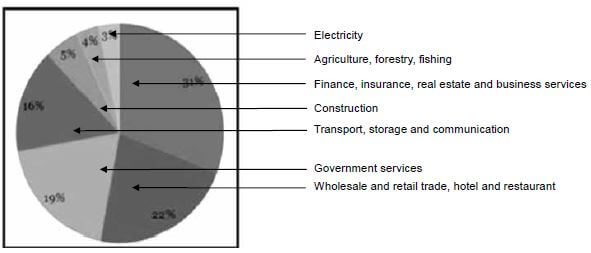
FIGURE 1B: SOUTH AFRICAN GDP 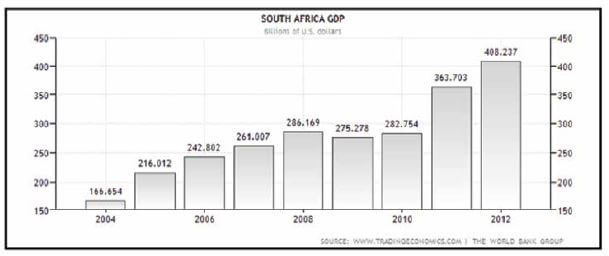
FIGURE 2: INDUSTRY AND MINING IN SOUTH AFRICA
Industry And Mining |
FIGURE 3: COEGA IDZ
THE COEGA INDUSTRIAL DEVELOPMENT ZONE The Coega Development Corporation (CDC) is a state-owned entity formed in 1999. It was mandated to develop and operate the Coega Industrial Development Zone (IDZ), which is located adjacent to the modern deep-water port facility, Port of Ngqura. |
4.2 Term 3 – Research task
Two examples of typical research tasks are provided below.
4.2.1 Learner guidelines for conducting research
Research framework for assessment (Guideline on administration of research task)
RESEARCH ACTIVITIES | STEPS | MARKS | LENGTH | TIMEFRAME |
Formulate the hypothesis/Problem statement | 1 | 5 | 50 words No more than | One week |
Background information about the study area | 2 | 6 | 75 to 100 words | |
Mapping | 3 | 5 | A4 size or smaller | |
Data collection | 4 | 6 | 75 to 100 words | Two weeks |
Analysis and synthesis of data | 5 | 15 | 300 to 450 words | One week |
Recommendations and possible solutions | 6 | 6 | 75 to 100 words | |
Conclusion – accept or reject the hypothesis | 7 | 5 | 50 words No more than | One week |
Bibliography | 8 | 4 | ||
Cover page | 3 | |||
Presentation | 5 | |||
TOTAL | 60 | |||
Submission | 9 | Due date |
In choosing a topic for research, isolate topics in specific areas in the Geography CAPS content that you have studied in Grade 12.
4.2.2 Guidelines for research
Research Task
Step 1: Formulating a hypothesis/problem statement
As Geographers we seek to understand and explain the interactions amongst humans, and between humans and the environment in space and time. This is achieved by asking questions or making informed geographical decisions. This entails the development of a hypothesis or a problem statement to be tested.
- You have to choose a specific area of study where a geographical problem exists.
- During this stage, a geographical question showing a problem is asked.
- Identify the problem from a local area.
- Formulate a hypothesis or a problem statement. (Hypothesis research is used to prove that certain variables are dependent on or independent of each other. Problem statement research is only to highlight that a specific problem exists in a specific community.)
- You should then follow the steps of research to ensure that the geographical question is answered.
A possible hypothesis in Settlement Geography: Rural-urban migration 
A possible hypothesis in Geomorphology: Catchment and river management 
Other possible hypothesis-type research examples:
- The value of property along north-facing slopes is higher than the value of property along south-facing slopes in Meyersdal, Gauteng (choose local area).
- The cause of rural-urban migration in Ndwedwe, KwaZulu-Natal (choose local area), is the lack of service delivery in the health sector.
- Climate change will impact negatively on grape farming and related industries in the Western Cape.
- The closing down of many primary schools in Lusikisiki (Eastern Cape) (choose a local area) is due to a decline of the population in the age group 7 to 15 years.
- The poor condition of roads (specify the names of the roads) leading to/in Harrismith, Free State (choose local area), is due to the lack of proper planning by the local municipality.
- The impact of building a dam along the Jukskei River in Gauteng (choose local area) upstream of Alexandra will reduce flooding and the subsequent loss of life in Alexandra.
- The e-toll system will impact negatively on the economic position of people using private transport in Gauteng.
- The e-toll system will impact positively on traffic flow to the major urban centres in Gauteng.
- Informal settlements in the Vhembe district of Limpopo have low levels of development due to the lack of provision of basic needs (choose ONE informal settlement in your local area).
- Overcrowding of informal settlements is due to the lack of proper planning by the local government (choose local area).
Step 2: Background information about an area of study
- You must explain where in South Africa the study area is located. (This can be indicated on the map.)
- Describe the study area in terms of its exact position (degrees, minutes and seconds).
- Provide relevant information about the area, for example population of the area or climate of the area.
Step 3: Mapping
- You must provide a map of the area in question.
- During this stage you must create a buffer zone around the area where the geographical problem exists.
- The map should have a clear legend/key and must be drawn to scale. The scale must be indicated on the map.
- If the map used covers a wider area, buffer zones around the area of study should be created.
- The map used should be the most recent map of the study area.
Step 4: Methods of data collection
- PRIMARY DATA SOURCES
- The use of questionnaires
- Interviews
- Observations
- Field trips
- SECONDARY DATA SOURCES
- Newspaper articles
- Government department statistics
- Books
- Internet
Step 5: Analysis and synthesis of data
- Use collected data now to formulate a discussion around the existing geographical problem.
- At this stage you should represent some of the information graphically where necessary, for example graphs and sketches.
- Analyse graphic information during this stage.
Step 6: Recommendations and possible solutions
- You should now make recommendations to solve the geographical problem in question.
- You should present your original and realistic opinions as far as you possibly can.
Step 7: Conclusion – accept or reject the hypothesis
- You should now take a decision to either ACCEPT or REJECT the hypothesis.
- Give reasons for either ACCEPTING or REJECTING the hypothesis.
Step 8: Bibliography
- You must include a comprehensive bibliography.
- List websites in full.
- You must include annexures of questionnaires and interviews conducted.
Step 9: Submission
- You must include graphs, tables, diagrams and pictures where necessary.
- On submission, ensure that a suitable cover page is included.
4.2.3 Compiling a bibliography for a research task
- For a book:
Author (last name, initials). Title of Book (Publishers, Date of publication).
Example:
Dahl, R. The BFG. (Farrar, Straus & Giroux, 1982).
- For an encyclopaedia:
Encyclopaedia Title, Edition date. Volume number, ˈArticle Titleˈ, page number(s).
Example:
Encyclopaedia Britannica, 1997. Volume 7, ˈGorillasˈ, pp. 50–51.
- For a magazine:
Author (last name first), ˈArticle Titleˈ. Name of Magazine. Volume number, (Date): page number(s).
Example:
Jordan, Jennifer, ˈFilming at the Top of the Worldˈ. Museum of Science Magazine. Volume 47, No. 1, (Winter 1998): p. 11.
- For a newspaper:
Author (last name first), ˈArticle Titleˈ. Name of Newspaper. City, state publication. (Date): Edition if available, Section, page number(s).
Example:
Powers, Ann, ˈNew Tune for the Material Girlˈ. The New York Times. New York, NY. (3/1/98): Atlantic Region, Section 2, p. 34.
- For a website:
Quote the name of the website in full and underline.
Example:
http://www.sahistory.org.za/topic/womens-struggle-1900-1994
- For a person:
Full name (last name first). Occupation, date of interview.
Example:
Smeckleburg, Sweets. Bus driver. 1 April 1996.
- For a film/documentary:
Title, Director, Distribution, Year.
Example:
Braveheart, Director Mel Gibson, Icon Productions, 1995.
4.2.4 Proposed cover page for a research task
NAME OF SCHOOL | |
NAME OF LEARNER | |
SUBJECT | |
RESEARCH TOPIC | |
CURRICULUM CONTENT | |
Design cover suitable for research topic and place here
| |
STATEMENT OF AUTHENTICITY
I hereby declare that ALL pieces of writing contained in this research task are my own original work and that if I made use of any source, I have duly acknowledged it.
Learner’s signature: __________________________________ Date: _____________
4.2.5 Exemplar: Research task 1
- Curriculum content: Key human-environment interactions in urban areas: People and places – inner-city problems
- Compliant with CAPS.
- May be tested in the CAPS final external examination.
- One (1) research task must be done.
CRIME IN THE INNER CITY South African cities attract thousands of new residents every year in search of work and a better life. The housing shortage, along with a shortage of housing subsidies, means that for many South Africans there is no alternative but to live in informal housing and shack settlements. The rapid increase in informal settlements around the cities in South Africa has resulted in an increase in crime rates in the inner city. |
Compile your research by completing the activities outlined below.
Step 1: Formulate the hypothesis/problem statement
- Formulate your own hypothesis based on a problem you have identified, for example:
The increasing number of informal settlements (choose localised informal settlement) in and around urban areas in South Africa has resulted in higher crime rates within the inner city due to higher unemployment. (Focus: More people in surrounding informal settlements result in unemployment causing people to turn to crime.)
Step 2: Background information about the study area
Give a brief introduction and description (background information) of the city (study area) you have selected in terms of:
- Historical background
- Population
- Description of the location of informal settlements in relation to the inner city
- Other relevant statistical information
Step 3: Mapping
- Provide a map showing the position of the informal settlement in relation to the city that you have identified for your research task. (It is easier to choose your local area as an area of study.)
- The map should clearly indicate buffer zones where informal settlements are located.
- The map should include areas of the city that are regarded as crime ˈhotspotsˈ.
- The map must have a clear legend/key.
- The scale of the map must be indicated.
Step 4: Data collection
Collect data using at least THREE methods, for example:
- Questionnaires
- Interviews
- Field trips
- Photographs and maps
- Literature research (newspapers, magazines, books, et cetera)
- Internet research
Step 5: Analysis and synthesis of data
- Analyse the data that you have collected, and formulate a report on your findings. Support your findings with graphs, photos, et cetera.
- Briefly discuss how the existence of informal settlements contributes to crime in the inner city.
- Briefly discuss the contribution of high unemployment rates in the informal settlement to crime in the inner city.
Step 6: Recommendations and solutions
- Provide suitable recommendations and solutions to the problem.
Step 7: Conclusion – accept or reject the hypothesis
- Based on your findings in Step 5, you may either ACCEPT or REJECT the hypothesis.
- Give reasons for your conclusion.
Step 8: Bibliography
- Compile a bibliography for your research. If you have done any Internet research, you must provide the website(s) that you have used in full.
Step 9: Submission
- Collate all your information.
- Include a table of contents.
- Ensure that you include a copy of the questionnaire and/or questions asked in your interviews as annexures.
- Design a suitable cover sheet.
- Submit your research.
4.2.6 Exemplar: Research task 2
- Curriculum content: Physical Geography (fluvial processes)
- Compliant with CAPS.
- May be tested in the CAPS final external examination.
- One (1) research task must be done.
THE IMPACT OF HUMAN ACTIVITIES ON RIVERS Rivers obtain water from surface run-off and ground water of their drainage basins. Activities taking place in the drainage basin affect the quality of water in the river. |
Choose a river close to your school or where you live as an area of study, and conduct your research by following the steps outlined below.
Step 1: Formulate the hypothesis/problem statement
- Formulate your own hypothesis based on a problem you have identified, for example:
Human activities impact negatively on the quality of water and the flow pattern in the upper reaches/course of the Blood River in Limpopo. |
Step 2: Background information about the river under study
- Describe the provincial location of the river.
- Climate – particularly the amount of rainfall that is received.
- Vegetation
- Relief and topography
- Underlying rock structure
- Specify the river type, for example permanent, periodic.
- Describe the river stage (youth, mature or old age) at your study area.
Step 3: Mapping
- Provide a map showing the river being studied and the adjacent settlements.
- Create a clear buffer zone at the part of the river that is being studied.
- The map should have a clear key/legend.
- Indicate the scale of the map.
Step 4: Data collection
Collect data using at least THREE methods, for example:
- Questionnaires
- Interviews
- Field trips
- Photographs and maps
- Literature research (newspapers, magazines, books, et cetera)
- Internet research
Step 5: Analysis and synthesis of data
- Analyse the data that you have collected, and formulate a report on your findings. Support your findings with graphs, photos, et cetera.
- Use the above sets of data collected to determine the extent to which the river is affected by human activities.
- Explain in detail how the identified human activities impact on the quality of water and the flow pattern of the river.
Step 6: Recommendations and solutions
- In your opinion as a researcher, what would be the possible solution(s) to the negative impact caused by human activities in the river?
- Make long-term recommendations to the government department(s) leading to legislature to protect the river.
Step 7: Conclusion – accept or reject the hypothesis
- Based on your findings in Step 5, you may either ACCEPT or REJECT the hypothesis.
- Give reasons for your conclusion.
Step 8: Bibliography
- Compile a bibliography for your research. If you have done any Internet research, you must provide the website(s) that you have used in full.
Step 9: Submission
- Collate all your information.
- Include a table of contents.
- Ensure that you include a copy of the questionnaire and/or questions asked in your interviews as annexures.
- Design a suitable cover sheet.
- Submit your research.
4.2.7 Proposed marking rubric for a research task
NAME OF LEARNER: _________________________________________________________GRADE: __________
CURRICULUM TOPIC: __________________________________________________________________________
RESEARCH TOPIC: __________________________________________________________________________
MARK
| 1 | 2–3 | 4–5 | Teacher Mark | Moderator Mark | |||
Step 1
|
|
|
| |||||
MARK
| 1 | 2–3 | 3–4 | 5–6 | Educator Mark | Moderator Mark | ||
Step 2
|
|
|
|
| ||||
MARK
| 1 | 2 | 3 | 4 | 5 | Educator Mark | Moderator Mark | |
Step 3 |
|
. |
|
|
| |||
| MARK | 1 | 2–3 | 4–5 | 6 | Teacher Mark | Moderator Mark | ||
| Step 4 Data collection |
|
|
|
| ||||
| MARK | 1–3 | 4–6 | 7–9 | 10–12 | 13–15 | Teacher Mark | Moderator Mark | |
| Step 5 Analysis and synthesis of data |
|
|
|
|
| |||
| MARK | 1 | 2–3 | 4–5 | 6 | Teacher Mark | Moderator Mark | ||
| Step 6 Recommendations and solutions |
|
|
|
| ||||
| MARK | 0 | 1–3 | 4–5 | Teacher Mark | Moderator Mark | |||
| Step 7 Conclusion |
|
|
| |||||
| MARK | 0 | 1–3 | 4 | Teacher Mark | Moderator Mark | |||
| Step 8 Bibliography |
|
|
| |||||
| MARK | 0 | 1–2 | 3 | Teacher Mark | Moderator Mark | |||
| Step 9 Cover page |
|
|
| |||||
| MARK | 1–4 | 5 | 5 | Teacher Mark | Moderator Mark | |||
| Step 10 Presentation |
|
|
| |||||
| Teacher Mark | Moderator Mark | |||||||
| TOTAL: 60 | ||||||||
| SBA MARK: 60 ÷ 3 = 20 | ||||||||
EDUCATOR NAME: ______________________________DATE OF ASSESSMENT: __________________
MODERATOR NAME: ______________________________DATE OF MODERATION: __________________
5. CONCLUSION
This document provides you with a framework to develop your own research task. It also provides you with a framework of expectancy for data-handling tasks. The framework for data-handling tasks can also be used to prepare for external examinations where data-handling-type questions can be asked.
A clear guideline has been developed on how to conduct research. This guideline can be applied to any topic within the CAPS in which you wish to conduct research. The marking rubric that has been included will also provide you with a clear guide on the time that should be spent on the various phases of doing research.
The high standard of these tasks will provide a platform for you to develop skills such as research, interpretation of resources, integration of resources and graphs, all skills required for the final external Geography examination. These are also skills that can be put to use at a later stage in your life.
